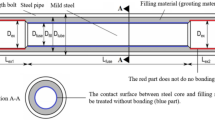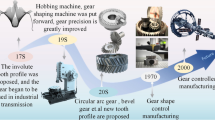Abstract
Case hardening, or surface hardening, is the process of hardening of a metal object at its outer surface while allowing its core to remain relatively soft, thereby forming a thin layer of harder metal at the surface. Currently, induction heating using high frequency current is applied to carry out this hardening process. We modeled this hardening process using the powerful Abaqus finite element tool and validated the results of the numerical analysis by comparing them with experimental results. Our model accurately predicted the hardened area at the outer surface of the metal for a steel sprocket. Future research will optimize the coil geometry and other parameters.
Similar content being viewed by others
References
J. F. Young, Induction heating for case hardening, IEEE Transactions on Magnetics, 13 (6) (1977) 1776–1785.
K. E. Telning, Steel and its heat treatment, Elsevier (1984) 554–564.
S. O. Hong, H. B. Kim and G. J. Cho, A study on improvement of workpiece deformation in high frequency heat treatment, J. of the Korean Society of Manufacturing Process Engineers, 2 (2) (2003) 31–36.
N. F. D. S. Guterres, Rusnaldy and A Widodo, The effect of temperature in induction surface hardening on the distortion of gear, IOP Conf. Ser. Mater. Sci. Eng., 202 (2017) 012092.
H. C. Ji, B. Wang and X. B. Fu, Study on the induction heating of the work piece before gear rolling process, AIP Conference Proceedings, 1896 (2017) 120010.
V. Esteve et al., Comparative study of a single inverter bridge for dual frequency induction heating using Si and SiC MOSFETs, IEEE Transactions on Industrial Electronics, 62 (3) March (2015).
D. W. Yun, H. C. Pack, J. H. Koo, S. Y. Ham and S. H. Lee, Investigation of heat treatment of gears using a simultaneous dual frequency induction heating method, IEEE Transactions on Magnetics, 51 (11) November (2015).
W. S. Shin and H. C. Park, Inverter for induction heating using simultaneous dual-frequency method, The Transactions of Korean Institute of Power Electronics, 16 (6) December (2011) 554–560.
Abaqus 6.12 documentation, benchmarks manual, 1.8 electromagnetic analysis, 13/2/2012 edition.
K. Sadeghipour, J. Dopkin and K. Li, A computer aided finite element/experimental analysis of induction heating process of steel, Comput. IND., 28 (1996) 195–205.
D. Tong, J. Gu and G. E. Totten, Numerical simulation of induction hardening of a cylindrical part based on multiphysics coupling, Modeling Simul. Mater. Sci. Eng., 25 (2017) 035009.
Y. Choi and J. H. Park, Control of surface temperature of an aluminum alloy billet by air flow during a heating process at elevated temperature, Journal of Mechanical Science and Technology, 30 (6) (2016) 2753–2758.
A. Candeo and C. Ducassy, Multiphysics modeling of induction hardeing of ring gears for the aerospace industry, IEEE Transactions on Magnetics, 47 (2011).
Methods of measuring case depth for steel hardened by flame or induction hardening process, KS D 0027(Material part of Korean Industrial Standards).
V. Rudnev, D. Loveless and R. L. Cook, Handbook of induction heating, CRS Press, 4 (2017).
Author information
Authors and Affiliations
Corresponding author
Additional information
Recommended by Associate Editor Jaewook Lee
Jin-Kyu Choi is currently studying his doctoral degree in School of Mechanical and Aerospace Engineering at Gyeongsang National University in Jinju, Republic of Korea. His research area includes induction heating and structural analysis.
Seok Soon Lee is working as a Professor in School of Mechanical and Aerospace Engineering at Gyeongsang National University in Jinju, Republic of Korea. He has been guiding many research scholars for many years. His research area includes finite element analysis, optimal design and also involved in numerous innovative researches. He completed his doctoral and graduate degree at KAIST, Korea.
Rights and permissions
About this article
Cite this article
Choi, JK., Park, KS. & Lee, SS. Predicting the hardening depth of a sprocket by finite element analysis and its experimental validation for an induction hardening process. J Mech Sci Technol 32, 1235–1241 (2018). https://doi.org/10.1007/s12206-018-0227-4
Received:
Revised:
Accepted:
Published:
Issue Date:
DOI: https://doi.org/10.1007/s12206-018-0227-4




